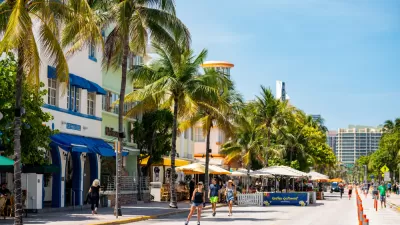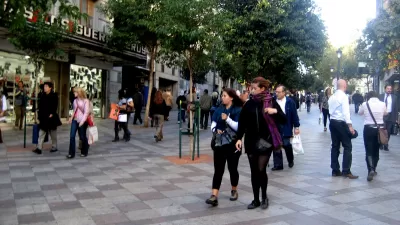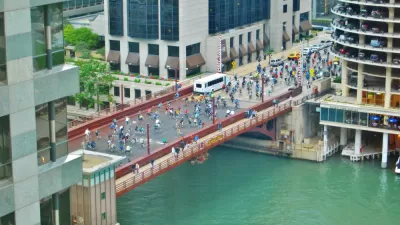"Slow streets" is a popular concept, but residents and community advocates say officials have to do more to make implementation effective and equitable.

With restricted access to most indoor spaces, the humble street got a lot of attention over the last year as cities reallocated right-of-way to pedestrians and public seating. Liz Farmer of the Lincoln Institute of Land Policy writes about Washington, D.C.'s experiment with "slow streets," a program which included 26 miles of road in the district. "While the concept of slow streets was generally well received," Farmer says, "its implementation in Washington and other cities was sometimes rocky—and sparked much-needed discussions about equity, access, and planning."
At a public hearing, residents expressed support for the concept, but disappointment at the execution. "Concerns included a lack of connectivity—among the slow streets themselves and between the streets and other destinations—as well as logistical aspects like traffic enforcement and signage." Residents also expressed concern that communities of color are being left out of the programs, partly due to local mistrust of programs seen as harbingers of displacement.
"The lessons surfacing in DC, which cover issues ranging from transportation inequities to signage logistics, could also be valuable to other cities that are initiating or expanding slow streets projects this year, from Nashville, Tennessee, to Omaha, Nebraska." One important lesson, according to Jessie Grogan, associate director of Reduced Poverty and Spatial Inequality at the Lincoln Institute, "is that cities need to be more intentional about the purpose of the streets in the first place—then design accordingly. 'If you want to get people from point A to B without getting in cars, then how do you do that safely for people walking or biking?'"
FULL STORY: Lessons from Washington, DC's Experiment with Slow Streets

Maui's Vacation Rental Debate Turns Ugly
Verbal attacks, misinformation campaigns and fistfights plague a high-stakes debate to convert thousands of vacation rentals into long-term housing.

Planetizen Federal Action Tracker
A weekly monitor of how Trump’s orders and actions are impacting planners and planning in America.

San Francisco Suspends Traffic Calming Amidst Record Deaths
Citing “a challenging fiscal landscape,” the city will cease the program on the heels of 42 traffic deaths, including 24 pedestrians.

Adaptive Reuse Will Create Housing in a Suburban Texas Strip Mall
A developer is reimagining a strip mall property as a mixed-use complex with housing and retail.

Study: Anti-Homelessness Laws Don’t Work
Research shows that punitive measures that criminalized unhoused people don’t help reduce homelessness.

In U.S., Urban Gondolas Face Uphill Battle
Cities in Latin America and Europe have embraced aerial transitways — AKA gondolas — as sustainable, convenient urban transport, especially in tricky geographies. American cities have yet to catch up.
Urban Design for Planners 1: Software Tools
This six-course series explores essential urban design concepts using open source software and equips planners with the tools they need to participate fully in the urban design process.
Planning for Universal Design
Learn the tools for implementing Universal Design in planning regulations.
Heyer Gruel & Associates PA
JM Goldson LLC
Custer County Colorado
City of Camden Redevelopment Agency
City of Astoria
Transportation Research & Education Center (TREC) at Portland State University
Jefferson Parish Government
Camden Redevelopment Agency
City of Claremont





























